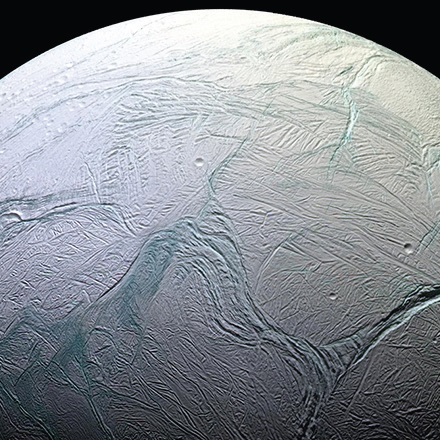Tribology and the Planets: Part II
R. David Whitby | TLT Worldwide November 2019
Evidence suggests life could exist on Enceladus, Saturn’s sixth-largest moon.

Enceladus’ elliptical orbit and gravitational forces from Saturn and Dione are thought to generate tidal heating.
Photo courtesy of NASA.gov.
In September I wrote about one of Jupiter’s moon, Io, and the tidal friction that makes it geologically active. While writing about Io, I came across another geologically active moon.
Enceladus is Saturn’s sixth-largest moon, 505 km (314 miles) in diameter, about a tenth of that of Saturn’s largest moon, Titan (5,149 km, 3,199 miles), and is mostly covered by fresh clean ice, making it one of the most reflective bodies in the solar system. Its surface temperature at midday only reaches -198 C (-324 F), far colder than a light-absorbing body would be.
William Herschel discovered Enceladus in 1789, but little was known about it until the Voyager 1 and Voyager 2 spacecrafts passed nearby in the early 1980s. In 2005 NASA’s Cassini spacecraft started multiple close flybys of Enceladus, revealing its surface and environment in greater detail.
Enceladus orbits Saturn at an average distance of 237,948 km (147,854 miles), between the orbits of two other moons, Mimas (diameter 396 km, 246 miles) and Tethys (diameter 1,062 km, 660 miles), and within the densest part of Saturn’s E ring. Enceladus is tidally locked with Saturn, keeping the same face toward the planet. It also is locked in an orbital resonance with Dione, a larger moon (diameter 1,123 km, 698 miles), which orbits at an average distance of 377,396 km (234,503 miles). Enceladus orbits Saturn twice for every one Dione orbit, and Dione’s gravity stretches Enceladus’ orbit into an ellipse.
Parts of Enceladus show craters up to 35 km (22 miles) in diameter, while the south polar region is almost entirely free of impact craters. This area also has large ice boulders and regions carved by tectonic patterns.
In 2005 Cassini observed icy water particles and gas gushing from the moon’s surface at approximately 400 meters per second. The eruptions appear to be continuous, generating an enormous halo of fine ice dust around Enceladus. More than 100 jets have been identified. Some of the water vapor falls back to the surface as snow; the rest escapes and supplies most of the material making up Saturn’s E ring. It’s the snow that keeps Enceladus’ surface bright. From gravity measurements and the magnitude of the moon’s very slight wobble as it orbits Saturn, scientists have determined that the jets are supplied by a sub-surface ocean. Scientists believe the moon’s ice shell may be as thin as 1-5 km (0.6-3 miles) at the south pole.
During a flyby in 2005, Cassini’s composite infrared spectrometer found a warm region near the south pole. Temperatures in this region ranged from 85 to 90 kelvin (K) (-188 to -183 C), with small areas showing as high as 157 K (-116 C), much too warm to be explained by solar heating and indicating that parts of the south polar region are heated from the interior of Enceladus. An estimated heat flux of 200 mW/m
2 is about 10 times higher than that might be explained by radioactive decay alone.
Like Jupiter’s moon Io, Enceladus’ elliptical orbit and gravitational forces from Saturn and Dione are thought to generate tidal heating. A computer simulation, published in November 2017, that used data from Cassini, suggests that frictional heat generated by sliding rock fragments within the permeable and fragmented core of Enceladus could keep its underground ocean warm for billions of years. It is thought that if Enceladus had a more eccentric orbit in the past, the enhanced tidal forces and a periodic enhancement in eccentricity could be sufficient to maintain a sub-surface ocean that periodically changes in size.
Since the ocean in Enceladus supplies the jets, and the jets produce Saturn’s E ring, studying material in the E ring provides clues to the nature of Enceladus’ ocean. The E ring is mostly made of ice droplets, but among them are peculiar nanograins of silica that only can be generated where liquid water and rock interact at temperatures above about 200 C. This, among other evidence, points to hydrothermal vents deep beneath Enceladus’ icy shell, not unlike the hydrothermal vents found on Earth’s ocean floor.
In June 2018, scientists reported the detection by Cassini of complex macromolecular organic compounds in Enceladus’ jet plumes. Traces of ammonia also have been found. With its sub-surface ocean of water, unique chemistry and internal heat, Enceladus has become a promising candidate in the search for places where life could exist.
David Whitby is chief executive of Pathmaster Marketing Ltd. in Surrey, England. You can reach him at pathmaster.marketing@yahoo.co.uk.